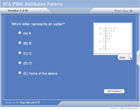Distribution Patterns
| Topic Review on "Title": |
- Shape: the form a graph takes when all data points have been accounted for.
- Center: approximately the center of data.
- Spread: the distance between the minimum and maximum values in a data set.
- Symmetric: both sides of the graph are approximately the same shape.
- Left skewed: the left tail of the distribution extends farther than the right.
- Right skewed: the right tail of the distribution extends farther than the left.
- Outliers: observations, or data points that do not fall within the pattern of the distribution.
|
| Rapid Study Kit for "Title": |
| Flash Movie |
Flash Game |
Flash Card |
| Core Concept Tutorial |
Problem Solving Drill |
Review Cheat Sheet |
 |
 |
 |
|
| "Title" Tutorial Summary : |
This tutorial covers four major aspects of distribution patterns: describing the overall pattern of a graph, classifying a distribution as symmetric, left skewed or right skewed. Identify the outliers of a distribution and use shape, center, and spread to describe graph patterns.
You will learn how to examine shapes, measure center and spread and so by finishing this tutorial you will be able to describe the shape, center and spread of a certain distribution.
|
| Tutorial Features: |
Specific Tutorial Features:
- Examples showing the shape, center, outliers and spread of the distribution are discussed.
- Practical examples are used to illustrate how one can describe the shape, center, outlier and spread of the distribution.
Series Features:
- Concept map showing inter-connections of new concepts in this tutorial and those previously introduced.
- Definition slides introduce terms as they are needed.
- Visual representation of concepts
- Animated examples—worked out step by step
- A concise summary is given at the conclusion of the tutorial.
|
| "Title" Topic List: |
- Describe a distribution of data using shape, center, and spread.
- Common shapes of a distribution are symmetric, left skewed or right skewed.
- Outliers could indicate errors or special cases in data.
- Spread accounts for the distance between the minimum and maximum observations.
|
See all 24 lessons in Introductory Statistics, including concept tutorials, problem drills and cheat sheets:
Teach Yourself Introductory Statistics Visually in 24 Hours |



